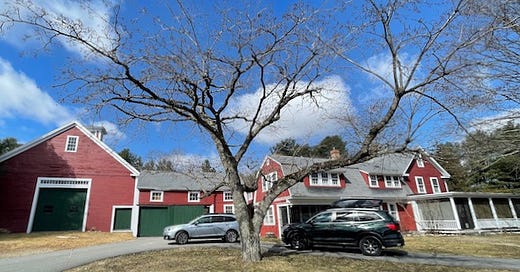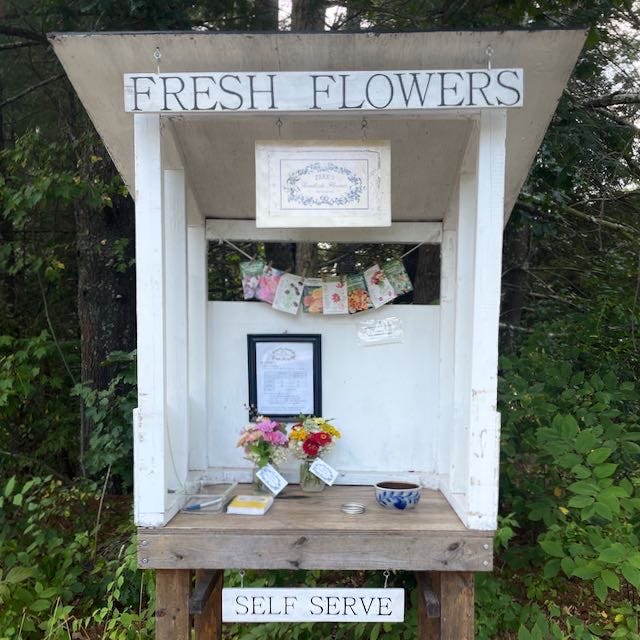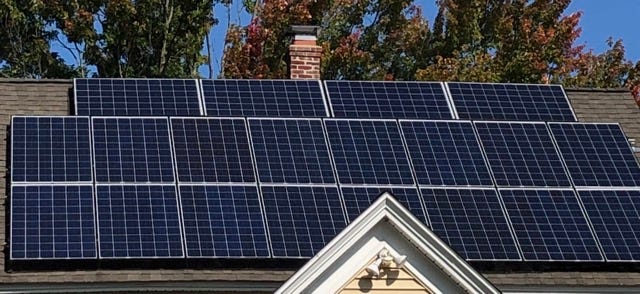Working and Living
Taking inspiration from Wendell Berry to explore the ways we can make our homes more productive places
Welcome to the Quarantine Creatives newsletter, a companion to my podcast of the same name, which explores creativity, art, and big ideas as we continue to live through this pandemic.
If you like what you’re reading, you can subscribe for free to have this newsletter delivered to your inbox on Wednesdays and Sundays:
Last week, I talked about some of the lessons that I’ve learned as I started reading Wendell Berry’s The Unsettling of America. The book was first published in 1977, but it’s amazing just how relevant and contemporary it feels. I have not finished reading it yet, but continue to be inspired deeper that I get.
For example, Chapter Five opens with this passage that really spoke to me:
“It is impossible to divorce the question of what we do from the question of where we are- or, rather, where we think we are. That no sane creature befouls its own nest is accepted as generally true. What we conceive to be our nest, and where we think it is, are therefore questions of the greatest importance. Do we, for instance, carry on our work in our nest or do we only reside and get our mail there? Is our nest a place of consumption only or is it also a place of production? Is it the source of necessary goods, energies, and ‘services,’ or only their destination?”
Berry is comparing farm life, where a homestead may produce vegetables, fruit, meat, eggs, and milk for itself, with our newer suburban lifestyle. These days, a home is mostly a place to park our cars at night, sleep, and consume food and media, but it wasn’t always this way.
There’s a home in my neighborhood that I pass frequently on my walks that really illustrates this change. It was built around 1800 and has clearly been added to over time.
The property not only consists of the house and barn in the photo above, but there are several out buildings as well. These are smaller barns and sheds that likely once held animals and/or farm equipment. There is also what looks to me like an old smokehouse where meat would have been cured for long term storage.
At one time, the occupants of this house would have grown crops, raised animals, fed their family, and sold their excess crops, meat, eggs, and milk to others. It’s an old world existence, one that we tend to romanticize. I interviewed Lidia Bastianich about her childhood in the Istrian Peninsula and was enthralled by her stories about growing and preserving food and baking bread in a communal oven in the center of town. This lifestyle seems exotic, but it was within reach in this country not that long ago.
These days, the home pictured above is surrounded by grass; there are no animals in the barn, no chickens in the yard. I don’t fault the owners of this beautiful farmhouse for not being farmers. Most of my community shifted long ago from farmland to housing commuters that work in and around Boston.
But Berry brings up an interesting idea: when we separate work and home into two separate places, we may be losing an essential part of being human. We are no longer rooted in our land, and instead become transient. We move because of work opportunities, even if it takes us away from everything familiar.
“Once, some farmers, particularly in Europe, lived in their barns- and so were both at work and at home. Work and rest, work and pleasure, were continuous with each other, often not distinct from each other at all. Once, shopkeepers lived in, above, or behind their shops. Once, many people lived by ‘cottage industries’- home production. Once, households were producers and processors of food, centers of their own maintenance, adornment, and repair, places of instruction and amusement. People were born in these houses, and lived and worked and died in them.”


We talk a lot about work-life balance these days, with the implication being that these are two distinct aspects of our personality that require some balancing. I think this is true for many modern industries. If your entire life is made up of emails, spreadsheets, and databases, relief is required.
The pandemic gave us a sampling of what combining life and work looked like. I acknowledge that this experience has been different for everybody, but for me, it has been such a positive shift. My work world and home life still do not overlap in the way Berry describes, but at least they run a bit more parallel.
When not commuting, I have more time to spend with my family and am contributing less pollution to the atmosphere. I also have been able to spend down time between calls or other work commitments being productive in other ways. Sometimes this means small things, like running a load of laundry in the background, but it can also be baking a loaf of bread or preparing dinner. It’s a small contribution, but it makes me feel more productive and better connected to “real life.”
According to Berry, by moving work out of the home, removing the production, preparation, and sometimes consumption of food away from our property, and by building homogenous neighborhoods where transport options are limited, we are contributing to our decline in several ways:
“With its array of gadgets and machines, all powered by energies that are destructive of land or air or water, and connected to work, market, school, recreation, etc., by gasoline engines, the modern home is a veritable factory of waste and destruction. It is the mainstay of the economy of money. But within the economies of energy and nature, it is a catastrophe. It takes in the world's goods and converts them into garbage, sewage, and noxious fumes- for none of which we have found a use…
“But nowhere is the destructive influence of the modern home so great as in its remoteness from work. When people do not live where they work, they do not feel the effects of what they do. The people who make wars do not fight them. The people responsible for strip-mining, clear-cutting of forests, and other ruinations, do not live lives immediately threatened by the consequences. The people responsible for the various depredations of ‘agribusiness’ do not live on farms.”
While Berry seems to long for an agrarian past that I don’t see us returning to at any real scale, I like to think that there are small ways to think about our patterns of consumption and production.
What follows are four ideas for small changes that can get us closer to a productive homestead. Some of these are lessons that I have learned in my own life, and others are born out of my experience visiting homes across the country in my time with This Old House.
Make Something
To borrow the phrase from David Picciuto, I have found that making things with my hands is one of the most rewarding practices. This can be the simple act of making a dinner from scratch, and can extend to more complex tasks like building furniture or renovating a house.
These skills take some time to master, but they can start humbly. I found that making sauerkraut was a great entry point into other forms of canning and preserving. Sauerkraut in its simplest form involves two ingredients, cabbage and salt, and the process can be done in about a week. While there are specialized fermentation kits that can make things easier (I prefer this one), a reused pickle or mayonnaise jar can be used in the beginning when learning the fundamentals.
The same goes for cooking. Opting to make a meal instead of ordering out is a positive step, even if it’s only a few times per week at first. It doesn’t have to be an elaborate dinner. Start with pasta and jarred sauce. That’s where I started. Eventually, I started making my own tomato sauce, and then even making my own pasta. But if I didn’t take the first step of boiling pasta on the stove rather than ordering it out, I wouldn’t be the cook I am today.
When it comes to starting woodworking, I was intimidated and unsure how to start. I spent much of my professional career surrounded by folks like Norm Abram, who was building complicated Shaker furniture out of expensive cuts of cherry using thousands of dollars in power tools. It seemed out of reach for me; too precise and too skilled.
When we toured Nick Offerman’s wood shop, Nick offered some advice for beginning woodworkers: start with a piece of maple, use a handsaw to cut it to size, then use a hand sander to sand it down. Oil it and voila- you’ve made a cutting board.
This reframing of woodworking, from something complex that involved specialty tools to something that could be accomplished for less than $50 and a little sweat, was a revelation. I also liked that the end product was a useful and practical item.
When we make things that we need like cutting boards, tables, and desks, it turns a hobby into a practical exercise, which can lead to more fulfillment.
Grow Something
The suburban landscape is all about decoration. Lawns are well watered, well fertilized, and well manicured, but hardly functional. Flowering plants like rhododendron, azalea, and hydrangeas mask the foundation. A landscape is merely meant to be appreciated by cars passing, a decoration more than a place with purpose.
While Berry would like all of us to be farmers and understand the life cycle of our food, there are small ways to grow food, even in the least rural of settings.
Blueberries can make good foundation plantings that have the bonus of providing fruit in the summer. Herbs can be purchased nearly anywhere at a low price and many are perennial, meaning they return year after year and get bigger with age. They make a beautiful plant to cascade over a garden wall, can be harvested for culinary uses, and often attract butterflies and honeybees to a yard.
I’ve been struck by the number of what I refer to as “microfarms” popping up around me lately. Unlike traditional farms that have large acreage and rely on at least some heavy machinery to operate, these microfarms are often backyard affairs. Their operating hours are unpredictable, their stock can fluctuate, and they are often little more than self-service stands at the side of the road.
I have seen stands selling fresh cut flowers, eggs from backyard chickens, and excess produce from backyard gardens. They almost always include a QR code to send money via Venmo, PayPal, or a similar online payment service.
The people running these farmsteads are not professional farmers and their homes are almost always right in the middle of suburbia. Still, they are taking their plot of land, making it productive, and sharing the bounty of that effort with their neighbors.
It’s a side hustle that beautifies the neighborhood and gets us all a little closer to food production and a little further from agribusiness, which I see as a positive.
Make Energy
This one can be a little harder depending on where you live, but thanks to the falling cost of alternative energy and incentives from the recently passed Inflation Reduction Act, it is becoming easier than ever to become a net producer of energy rather than a net consumer.
We had solar photovoltaic panels installed on the roof of our 1910 home more than a decade ago, and they have been a worthwhile purchase. The panels convert solar energy into electricity, powering our lighting, refrigeration, and other electrical needs during the day.
Our system is grid-connected, meaning it feeds power to our neighbors’ houses when we produce more than we need (and we receive a utility credit for that power). We are still reliant on the grid at night or on cloudy days, but battery technology is advancing to the point that a home could be fully self-sufficient with the right-sized solar array and battery bank.
It’s also worth discussing geothermal, which is a method of heating and cooling a home by tapping into the earth’s constant temperature when you get below the surface layer.
Geothermal was once an expensive technology, but improvements in digging technology for the wells that power these systems as well as strong federal incentives make them worth considering. When paired with solar power, a geothermal system can be fully renewable.
Drive Less
Unfortunately, many of our suburban places are built to only accommodate cars. It can be difficult and dangerous to attempt to walk, bike, or take public transit to run errands.
If you live in a place like this, the best option may be to simply be more conscious about when and where you drive. Is it possible to combine nearby errands so they can be accomplished in one trip instead of several?
For those that are fortunate enough to have access to alternative forms of transit like bike paths, walking trails, buses, or train service, are you utilizing them to their fullest potential? So often in America, we view cars as the default, but it doesn’t need to be that way.
American tourists often remark about the walkability of European cities, not realizing that there are policies happening behind the scenes that preserve older street forms, allow for mixed use development, and encourage non-auto transportation. Car-first infrastructure is a choice, and we can choose a different path. I had hoped that some of the changes of the pandemic, like turning parking spaces into outdoor dining venues, would stick. It remains to be seen whether we are moving in a new direction or will revert to our old ways.



I’m finding that Wendell Berry’s ideas are often very large and all encompassing. I am likely doing a disservice to his vision by oversimplifying his writing, but I also believe that you need to crawl before you can walk. We all play a role in making our communities a little nicer and in making our lives and the lives of those around us a little better.
Capitalism tells us that the best way to contribute to society is to commute long distances, perform abstract work for lots of money, and then use that money to consume more.
While fully divesting from this cycle is challenging if not downright impossible, I like to hope that there are little ways that we can fight the pressure of consumption and make our homes productive places again. It starts small, and then it grows.
Related Reading
Getting Acquainted with Wendell Berry
If you’d like to catch up on past episodes of the Quarantine Creatives podcast, they can be found on Apple Podcasts, Spotify, or wherever you listen.
Please consider sharing this with a friend that you think might enjoy it, or better yet, share it on social media so you can tell hundreds of friends!
If you’ve missed past issues of this newsletter, they are available to read here.
Stay Safe!
Heath









